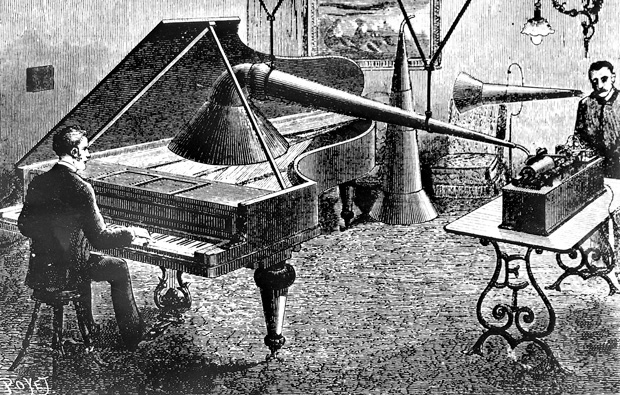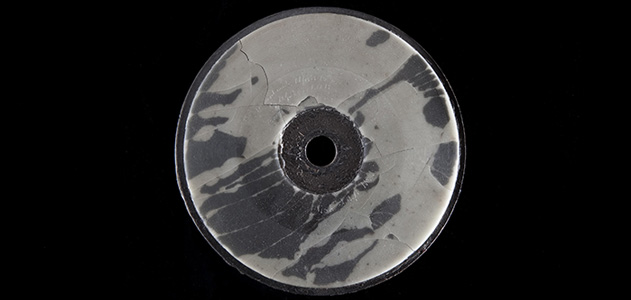The engineer remastered the original recordings of Thomas Edison.

It is believed that the technology of recording sound on physical media with the ability to play such recording was created by Thomas Edison in 1877. The system was purely mechanical. In order to write something, a person had to speak in a special socket. Next to the same bell one could play musical instruments if one wanted to keep a record of music.
At the other end of the socket was a diaphragm that vibrated under the influence of a sound wave. A needle was attached to the diaphragm, which also vibrated, knocking out tracks on a moving cylinder or disk (disks began to be used several years after the cylinders and were gradually replaced). In order to reproduce the recorded sounds, it was necessary to rotate the cylinder or disk, having previously installed another needle from the playback system. The needle moved because of irregularities and made the diaphragm vibrating, which produced the sound as a result. This sound was amplified by the bell.
Such a mechanical system existed until the 20s of the last century, when the mechanics was replaced by an electrical system with a microphone. The invention was made on time: the technology very quickly became popular. Many famous musicians, after learning about the invention, sought to acquire a system developed by Edison, and recorded their voices or music. Of course, the records were not of very high quality, and the media quickly deteriorated. This is especially true for cylinders or discs with wax, which are difficult to keep intact for tens or even hundreds of years.
')
Recovery of sound recordings from such media has already been learned. In 2013, for example, experts from the Smithsonian Institution were able to digitize the earliest known recording of the voice of Alexander Bell, which he made himself. Restoration was carried out from a cardboard disc covered with wax. Bell at that time experimented with various materials to create such discs, including metal, glass, cardboard, foil and wax. Such records are kept in the vaults of some museums, but until a certain time nobody touched them, so as not to damage them. And only the advent of laser technology has opened up the possibility of recovering sounds recorded on such media.

Usually, when recovering, specialists remove the distortion caused by scratches, chips and other problems with the media. According to the engineer Mark Hildebrant (Mark Hildebrant), this method of sound recovery is good, but it does not take into account the problems that could arise (and have arisen) at the time of recording. “This area has never been seriously considered by restorers. Most of the old recordings we now have are sound cleaned from noise. In the recovery process, the sound quality was not affected in any way, ”says Hildebrant.
We are talking about the imperfection of the mechanical sound recording systems of the time. One such system is shown in the image placed at the very beginning of the material. The frequency of the vibrations of the recording needle was limited, and this led to the cutting off of most of the frequency spectrum of the sound. In particular, frequencies below 300 Hz were not available with this recording method. Hildebrant decided to correct this moment, using modern technology. Knowing the range of sound used by the musical instruments used on the recordings, he simply added the cut low and high frequencies, thus restoring the original sound of the melody. Of course, this is also not an ideal job, but the quality of the recording is already much higher than what can be achieved with normal recovery. Listen to two recordings restored by various methods here .
In his work, the engineer used software from Diamond Cut Productions. It allows you to generate subharmonics as part of a digital signal chain. Thanks to this, Hildebrant managed to add the missing bass frequencies to the old Edison records. He also removed most of the noise, optimizing the sound of the melody.
Over the restoration of various audio recordings, Hildebrant has been working for more than five years. “There is always something to improve. It never ends, ”he says. Hildebrant like the technical side of things, and music. In particular, we are talking about the possibility of restoring the earliest examples of jazz music. According to the engineer, Edison was not too fond of jazz, so finding records of this kind is difficult. But still they are, and now Hildebrant is looking for them and putting them in order.
Similar work is being done by other specialists. For example, at the Smithsonian Institution, a whole laboratory does this. As mentioned above, it was this institution that was able to restore the recording of the sound of Alexander Bell’s voice. The Smithsonian Institution also stores other discs with music and voices recorded in the 1880s. There are about 400 such disks and cylinders transferred to the Bell Institute. Some records from such media have already been restored by specialists, others are not, the work is still ongoing.
Source: https://habr.com/ru/post/401225/
All Articles